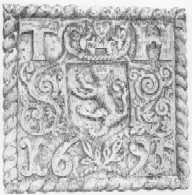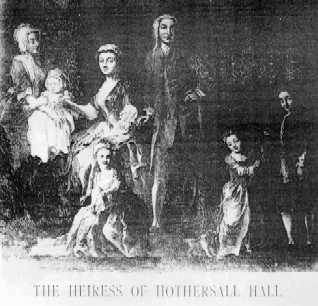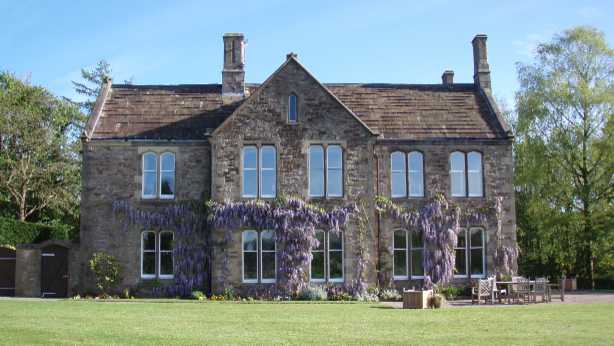Hothersall Hall
Hothersall of Hothersall Hall
Arms: Azure, a Lion Rampant Gardant Or.
Hothersall Hall was the residence of the ancient Hothersall family, the Lords of the Manor of Ribchester, before the Norman invasion (1066). Allied by intermarriage with the Hoghtons of Hoghton, Rishtons of Dunkenhalgh, Cromelholmes of Dutton, Talbots of Salesbury, Walmsleys of Showley and other ancient Lancashire families, the Hothersalls could show as proud and unbroken a descent from the time of the Conquest as any other family in the county.
The Hothersall family was descended from Robertus de Hadreshall, who held two bovates of land in Hadreshall during the reign of King Henry the 2nd. His son, Warinus de Hudersal (c.1199), was the father of Swane de Hundreshall, whose son was Thomas de Hedreshall (died c.1256). His son, Robertus de Hudersall, died c.1288 was the father of John de Hudersal, whose son was Robertus de Hudreshale. His son was Thomas de Hodersall who married Margeria (c.1311), daughter of Ricus de Hocton, (Hoghton). Their son, Robertus de Hodersale had a son, Ricardus de Hodiersale who married Emma and were living at Hothersall Hall c.1373. Their son Adam de Hodersall was living at Hothersall Hall c.1385. His son Robertus de Hodersall was living at Hothersall Hall c.1416, whose son was Ricardus de Hodersall. His son, Robertus de Hethersall, married Isabel, daughter of Ric Rishton de Rishton et Dunkenhalgh and they were living at Hothersall Hall c.1536. Their son, Johannes de Huddersall, married Anne, daughter of John Talbot, of Salesbury, by his first wife Anne, daughter of Hugh Sherburne, of Stonyhurst. His name appears in a list of obstinate Catholic recusants reported in Queen Elizabeth's reign (I). The family was always noted for its staunch adherence to the faith. Robertus and Isabel also had a daughter, Margaret who married Richard Cremblehome, of Dublin.
Johannes and Anne had three sons. Their first son, Richard Hothersall married Alice, daughter of Thomas Walmsley, of Showley Hall and sister to Sir Thomas Walmsley of Dunkenhalgh. Richard died c.1610. The second son was John Hothersall and the third son was George Hothersall. George went to Douay College in 1585, thence proceeded to the English College at Valladolid, in 1590, and after being ordained priest there, returned to England in 1593, and served the mission at or about Hothersall. He was imprisoned for being a priest, and exiled, when he was admitted to the Benedictines, in 1615. He then returned to the English Mission, and probably died at Hothersall Hall c.1633.
Richard and Alice had two sons. The first son was John Hothersall, born c.1584, died 1632, who married Maria, died 1641. The second son, Thomas Hothersall, was born c.1584 and married Bridget, daughter of William Haydock, of Cottam Hall, and by his wife, Bridget, daughter of Sir Richard Hoghton, of Hoghton Tower. Thomas Hothersall suffered heavily for recusancy.
Thomas and Bridget had three sons and a daughter. Two of the sons lost their lives in defence of their sovereign. The first son was John Hothersall, a captain in the royal army, slain at Greenhalgh Castle near Garstang in 1645. He suffered fines for recusancy. John married Margery, daughter of James Wall of Preston, and by his wife, Isabel, daughter of William Travers, of Nateby Hall. The second son George Hothersall, a lieutenant in the royal army lost his life at Liverpool in 1644. The third son, William, resided at Alston, and, with his wife Grace, suffered severely under the law against recusants. The daughter Elizabeth, married her cousin, Cuthbert Haydock, of Cottam.

John and Margery had three sons and two daughters. The first son, Thomas, born 17 March 1643, died an infant. The second son, Thomas, born 1644, married Cath on 9 January 1688, daughter of Lancaster, of Rainhill Hall. The third son, John died young. The first daughter, Jane, married Laurence Cottam, of Bannister Hey, Claughton. The second daughter, Alice, married John Lathom, of Sowereby. Thomas died in 1719. It is possible that he was executed along with Thomas Shuttleworth of Alston Old Hall, for their part in the Jacobite Rising of 1715.
Thomas and Cath had one son and five daughters. The first son, John Hothersall, joined the Chevalier de George in 1715, attained, convicted of high treason, and outlawed, but hid himself, and spent the last years of his life with his sister, Mrs Anne Leckonby, at Great Eccleston. He died unmarried before 1750. The first daughter, Anne, married William Leckonby and lived at Leckonby House, Great Eccleston. Their other daughters were Isabel, Margery, who married Edward Winstanley of Pemberton, Sarah and Grace.
William and Anne Leckonby's eldest son and heir, Richard Leckonby, inherited Hothersall Hall and Manor. The estate comprised the demesne lands belonging to the Hall, Brown House, Wilkinson's, Oxheys, Walshouse, Cockhill, Ingham's, Slater's, Hacking's, Rogerson's, Home's, and Crosse Hall.

The Leckonbys became extinct by the marriage of the last daughter of the house, Mary, great granddaughter of William Leckonby, with T.H.H. Phipps, High Sheriff of Wiltshire.
The Hothersall Hall estate was sold by the Phipps towards the end of 18th Century, and after passing through the Allertons, the Peddlers and Culcheths, became the property of Jonathan Openshaw, in 1853.
Jonathan Openshaw pulled down the old hall, the historic residence of the Hothersalls, which was in a derelict state. The present Hothersall Hall was completed in 1856 and was built in the gothic style. Jonathan Openshaw also greatly improved the land, and was known as a just but generous landlord.
Jonathan Openshaw died in 1882 and his nephew, Frederick Openshaw JP, born 1838, inherited the estate from him. Frederick Openshaw died c.1912 and the estate passed to his son, James Openshaw JP. At this time the estate embraced nearly 2000 acres in the townships of Hothersall, Ribchester and Alston. It comprised 38 farms varying in size from 18 to 147 acres, plus Home Farm, which had an area of about 250 acres.
During the twentieth century the estate was divided many times and the hall passed through numerous families.
In April 1998, Hothersall Hall was purchased in a dilapidated state and an extensive restoration project was undertaken over two years to modernise the hall whilst retaining character and reinstating original period features.
Ancient Traditions of Hothersall Hall
The Hothersall Boggart
In a fork of a tree on the lane above the hall can be found an horrific and grotesque stone head. This was dug up by a man at Hothersall and placed in its present position.
Some say that the head is that of the petrified Hothersall Boggart. Legend says that a demon from Hades had undertaken to oblige a local man with three wishes for the surrender of his soul.
The man's first two wishes were for wealth and great fortune but his third was a crafty move to avoid damnation. He wished the devil to spin a rope from the sands of the River Ribble, which was close at hand. In case of failure he must consent to be laid (buried) under a laurel tree there to turn into stone (for a demon cannot rot, only fuse to granite).

The devil and mate then went to the strand,
In a jiffey they twisted a fine rope of sand,
And dragged it along with them over the land;
But when they brought the rope to be washed,
To atoms it went - the rope was all smashed!
Each time the demon spun a rope the man poured water over the rope and it disintegrated. Eventually he gave up his efforts and accepted his fate, whereby the man of Hothersall escaped the devil's clutches and saved his soul. The devil is understood to have been laid under the roots of a large laurel tree at the end of the hall, and will not molest the family so long as that tree exists. It is rumoured that the roots have to be nourished with milk on certain occasions, in order to preserve its existence, and also to preserve the power of the spell under which the goblin is laid. The laurel here seems to have been invested with the mythical properties of the ash and rowan trees.
Rowan, ash, and red thread
Keep the devils frae their speed
Old Wives Tail
It is rumoured that it was common practice with the housewives in the district to tie a piece of red worsted thread round their cows' tails previous to turning them out to grass for the first time in the spring. It secures their cattle, from an evil eye, from being elfshot by fairies, etc.
